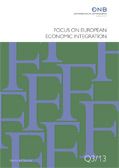Focus on European Economic Integration Q4/15
 OeNB
OeNB
- published:
- December 2015.
 OeNB
OeNB
Focus on European Economic Integration Q4/15 (PDF, 1.7 MB) December 2015.
Call for Applications: Visiting Research Program (PDF, 50 kB) Focus on European Economic Integration Q4/15 en Dec 31, 2015, 12:00:00 AM
Developments in Selected CESEE Countries: Robust economic expansion in almost all CESEE EU Member States, fragile growth in Turkey and recession in Russia (PDF, 634 kB) Focus on European Economic Integration Q4/15 Dec 31, 2015, 12:00:00 AM
Outlook for Selected CESEE Countries: GDP growth steady at 3% in CESEE6, recession to ease in Russia (PDF, 175 kB) Focus on European Economic Integration Q4/15 en Dec 31, 2015, 12:00:00 AM
The mixed success of EU-IMF adjustment programs in Europe – why Greece was different
(PDF, 450 kB)
Knollmayer, Riedl, Silgoner.
Riedl, Silgoner, Knollmayer – Focus on European Economic Integration Q4/15
The comparison of the economic, financial and fiscal conditions in four EU-IMF financial assistance countries shows that Greece’s economy was hit much harder during the crisis than Ireland, Portugal or Spain. While Greece has fallen back into recession and still depends on financial help from the international community, the adjustment programs appear to have been more successful in the other three countries.
The ongoing calamities of the Greek economy are partly the result of especially adverse starting conditions marked by manifold structural problems: Departing from a fairly low level, private debt in Greece surged rapidly. Economic growth in the pre-crisis years was thus credit-financed and consumption-based. This also applies to Ireland and Spain, which started with already comparatively high household debt levels. But in contrast to the latter two countries, credit growth in Greece was also high in the public sector, providing a strong procyclical stimulus to disposable incomes. This boosted domestic demand, whereas the performance of exports remained weak: As a consequence of rapidly growing unit labor costs, the export sector in Greece lost competitiveness, just as in Ireland, Portugal or Spain. It is the plurality of imbalances that makes the Greek case unique. The severity of the recession in Greece was also the result of the extremely strong and frontloaded consolidation efforts made in the middle of a balance sheet recession. These were prompted by the more stringent fiscal requirements in the Greek adjustment programs as compared to the other countries’ programs. Austerity measures seriously curbed domestic demand and could not stop debt from rising. Tight credit conditions and wage cuts additionally weighed on domestic demand and thus aggravated the recession.
Overall, the past years have shown that it was important and right to support countries in economic and financial difficulties. But experience with the Greek case has also taught us the limits of established forms of support which were not sufficiently underpinned by investment programs to support domestic demand.
en
EU-IMF program countries,macroeconomic imbalances,fiscal austerity
E24, E62, F32
Dec 31, 2015, 12:00:00 AM
Is there an added worker effect? – European labor supply during the crisis
(PDF, 536 kB)
Riedl, Schoiswohl.
Riedl, Schoiswohl – Focus on European Economic Integration Q4/15
This paper analyzes the responsiveness of an individual’s labor supply to the job loss of his or her partner – the so-called “added worker effect (AWE).” While the bulk of empirical studies have utilized discrete choice models to identify its existence, we provide a macroeconomic indicator of the AWE in order to assess its economic significance for the labor force participation rate (LFPR). Our empirical analysis focuses on Europe in the period from 2002 to 2012, revealing that the AWE is negatively related to the business cycle and was particularly pronounced during the global financial crisis. While the LFPR increased by roughly 1 percentage point in Europe from 2009 to 2012, half of the effect is attributable to added workers. As our indicator is based on a rich micro dataset (European Labor Force Survey) we are also able to consistently present individual country results for nearly all EU Member States. Our analysis shows high increases in added workers in euro area countries that were strongly affected by financial market stress and in EU countries that experienced the bursting of housing bubbles.
By contrast, we do not find an AWE in most Central and Eastern European countries.
en
labor force participation rate, unemployment, European countries
J22, J64, J82
Dec 31, 2015, 12:00:00 AM
Conference on European Economic Integration 2015: Boosting EU Competitiveness – The Role of the CESEE Countries (PDF, 145 kB) Silgoner, Steinacher, Wörz – Focus on European Economic Integration Q4/15 en Dec 31, 2015, 12:00:00 AM
Toward a Genuine Economic and Monetary Union (PDF, 171 kB) Breitenfellner, Veselý – Focus on European Economic Integration Q4/15 en Dec 31, 2015, 12:00:00 AM
Macrofinancial linkages and current account imbalances: a synopsis (PDF, 161 kB) Catão, Summer – Focus on European Economic Integration Q4/15 en Dec 31, 2015, 12:00:00 AM
Olga Radzyner Award Winners 2015 (PDF, 72 kB) Eller – Focus on European Economic Integration Q4/15 en Dec 31, 2015, 12:00:00 AM
Statistical Annex (PDF, 152 kB) en Dec 31, 2015, 12:00:00 AM
Notes (PDF, 124 kB) en Dec 31, 2015, 12:00:00 AM